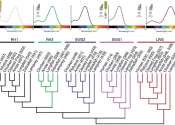Archaeobatrachia
Mesobatrachia
Neobatrachia
-
List of Anuran families
Frogs are amphibians in the order Anura (meaning "tail-less", from Greek an-, without + oura, tail), formerly referred to as Salientia (Latin saltare, to jump). The name frog derives from Old English frogga, (compare Old Norse frauki, German Frosch, older Dutch spelling kikvorsch), cognate with Sanskrit plava (frog), probably deriving from Proto-Indo-European praw = "to jump".
Most frogs are characterized by long hind legs, a short body, webbed digits (fingers or toes), protruding eyes and the absence of a tail. Most frogs have a semi-aquatic lifestyle, but move easily on land by jumping or climbing. They typically lay their eggs in puddles, ponds or lakes, and their larvae, called tadpoles, have gills and develop in water. Adult frogs follow a carnivorous diet, mostly of arthropods, annelids and gastropods. Frogs are most noticeable by their call, which can be widely heard during the night or day, mainly in their mating season.
The distribution of frogs ranges from tropic to subarctic regions, but most species are found in tropical rainforests. Consisting of more than 5,000 species described, they are among the most diverse groups of vertebrates. However, populations of certain frog species are declining significantly.
A distinction is often made between frogs and toads on the basis of their appearance, caused by the convergent adaptation among so-called toads to dry environments; however, this distinction has no taxonomic basis. The only family exclusively given the common name "toad" is Bufonidae, but many species from other families are also called "toads," and the species within the toad genus Atelopus are referred to as "harlequin frogs".









